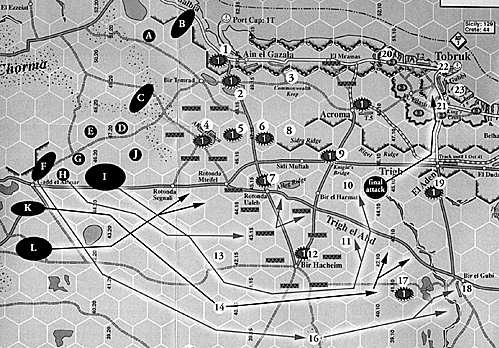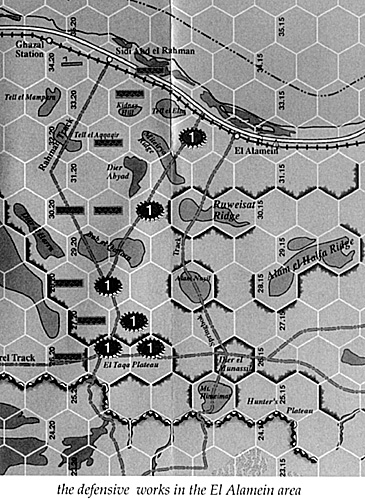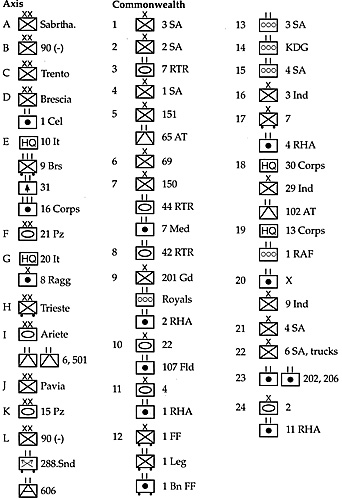My judgment of the design of a wargame depends not so much how the early turns can follow history, but on whether a player follow historical decisions with historical results throughout the game. I have found that many games begin to distort their results towards the middle and end. DAK, however, is a game which will give you historical results from historical decisions throughout the length of the game. So, if you want to change history, you have to do something different and this is what makes DAK an excellent simulation. This is also a game that you can start at any point and get a satisfying and illuminating experience.
There has been a lot written about the opening months of DAK, mostly how to defeat the Italian army quickly and at low cost. However, to this date very little if anything has been written or published on the game play in the last months of DAK which represent the high tide of Nazi conquest in North Africa.
This article will address a later phase of the campaign: the Gazala campaign, starting 26 May, 1942.
Initial Plans
DAK: Take the 15 Pz, 21 Pz, and Ariete around the south flank and engage CW Forces east of Bir Hacheim, which is not to be directly assaulted. Trieste is to attempt to clear minefield at B43.15. That hex is key to the defense as once it is cleared, Axis force can isolate Bir Hacheim and starve it out.
CW: Hold out long enough to reduce DAK forces and exhaust their supply. While admittedly not very imaginative (or aggressive), this plan takes into account CW weaknesses at this stage of the campaign, which are the long distance replacements have to travel, dispersed artillery, and a sub-par air force.

Initial setup and Axis attack plan; see key to unit
positions on the facing page;
for complete set-up information, see
scenario 7.14, DAK rules Vol. 1, pp. 50-53
Action
DAK plans worked fairly well. Clearing the minefield took a lot longer than anticipated. Meanwhile, the armor action to east of Bir Hacheim dragged on as DAK cleared the area east to Bir el Gubi. This turned into a battle of attrition where DAK eliminated Commonwealth brigades at a slightly higher rate than the replacements arrived. The front line east of Bir Hacheim slowly moved south until the Trigh Capuzzo was cut.
About ten turns into the battle, DAK was getting low on supply but the situation suggested a daring plan: take a combat group of a tank battalion, PzG regiment and recon battalion and try to over run the airfield at El Gubbi (hex B49.09) using internal supplies. It worked, and then DAK was able to resupply the group by air the next turn from Crete for a quick assault on Tobruk which also was successful. This assault was successful due mainly to the attrition effects from the previous turns which drew out a lot of the Tobruk garrison to man the front lines. This blow essentially decided the battle.
Another two turns passed before the Trigh Capuzzo was cleared of mines and the CW was clearly on the run; however, a division's worth of troops (four various brigades) were surrounded on the Trigh Capuzzo and were left behind. They lasted for 6 turns and provided quite a breakwater, tying up the bulk of the DAK infantry in reducing the pocket.
By mid-July the battle was over, and the Commonwealth was in full retreat. The Axis could not pursue because the battle had consumed every last iota of supply available. In retrospect, it was a very close decision. With massive replacements available, the Commonwealth was almost able to outlast DAK's supply. (The battle bore an eerie resemblance to the Gazala game, which I have since played.)
The CW decided to retreat all the way to the El Alamein position. Usually, 1 don't like long retreats and there appear to be several other places which would provide a strong defensive position, but I decided on Alamein just to see what would happen.
In retrospect, the DAK made a big mistake in not trying to pursue after the battle was won. I think that at least one panzer division should try to follow up quickly as the CW will be quite strung out on the road. The DAK also needs to advance as far as possible into the Alamein position before the Commonwealth can set up their remaining minefields. If the CW is allowed to set up a defensive position, the Axis advance is over. As it was, the DAK stayed in place, accumulating supplies and starving out the pocket of remaining Commonwealth troops. By mid August, the pocket was eliminated and DAK began its advance to the Alamein position, which had been built to an imposing size.
The CW forces built a defensive line D33.18 - D32.18 - D31.18 - D29.20 - D26.19, with the remaining minefields in front and using the salt marshes to limit the approaches. Hedgehogs were also built along the coast road and D26.19. As it turns out, this is one excellent defensive position. The CW artillery reorganization also increases their defensive abilities.
D26.19 is the key hex. As long as the CW controls this hex the desert flank is not open, and DAK is limited to direct, head-on attacks.
By the time DAK had reached this position in force, the CW had essentially completed their defensive preparations. In mid September, DAK attacked. It was very slow going, resembling WW1 combat at its finest. Lots of artillery barrages creating DGs, massive attacks for limited gains, and high casualties.
Once again, DAK ran out of supplies, but this time victory was not attained. In fact, although a dent was put in the CW's defenses, it wasn't much of a dent. The high CW replacement rate and superior supply net combined with the reorganized artillery (separate brigades) used in reserve to barrage in the reaction phase stopped DAK cold.
Meanwhile, the CW supplies and replacements kept on accumulating. With the arrival of the second B-24 unit (29 Aug., 42), the CW began an intermittent bombing campaign on the Axis ports, especially Tobruk. This effectively spread out the Axis fighters, and with better fighters in their inventory, the CW was able to contest the air superiority the Axis had enjoyed. On 1 October, the CW launched their counteroffensive.
 The defensive works in the El Alamein area.
The defensive works in the El Alamein area.
Once again, the battle resembled WWI but the difference this time was that the DAK could not replace their losses as the CW could. The CW made slow progress, clearing minefields as they went. By the end of October, the CW had reached a line D29.24 - D35.21, the DAK was holding on by their fingernails, and it was apparent that the dam was about to burst. At this point I ended the game as it was apparent that the CW had won.
Retrospective, things I will do differently next time:
- 1. Wait a few turns to launch the Gazala battle. More
supply will be available for pursuit and exploitation if /when DAK
wins the battle.
2. As noted above, DAK should /must pursue the CW after winning Gazala with whatever armor forces can be supplied. Allowing CW forces to escape and set up a defense around El Alamein will cause the defeat of the DAK.
Other Observations
It seems to me the Gazala position is rather weak. It is too far forward to take advantage of the Tobruk fortifications, yet Tobruk is close enough that it needs to be garrisoned with a significant force which takes away from the front-line defense. This observation seems to be confirmed by the recently published Gazala game (by the Gamers). Unfortunately, if you start a campaign at this point, this is the defensive setup you get. However, if I reached this point from an earlier campaign start, I wouldn't build a defensive line in this location.
Clearing minefields: Minefields are introduced in DAK and play a major role in the CW defensive schemes in the latter part of the campaign. Clearing them takes some planning, patience, and a significant amount of troops. I found the following plan to work fairly well:
1. Move a force of 2-3 REs with an AR of 4-5 into the hex when you have the second player phase of a turn. Plan to be DG'd by artillery in the reaction phase. 2. If you win the initiative, take the first phase and you can then remove one level (occurs during movement phase, opponent cannot interfere) Even if the opponent counterattacks and forces you out, you still have cleared some of the minefield. 3. Repeat the process.
I found that clearing minefields usually took at least 4 turns to accomplish, and many times took longer.
As the DAK, if you can't penetrate through the Alamein defense quickly, declare defeat and end the game to avoid the messy ending. Your opponent may want to continue to the end in order to get his turn to beat up on your forces, but essentially the DAK will be retreating from this point to the end.

Back to Table of Contents -- Operations #39
Back to Operations List of Issues
Back to MagWeb Master List of Magazines
© Copyright 2000 by The Gamers.
This article appears in MagWeb (Magazine Web) on the Internet World Wide Web.
Other military history articles and gaming articles are available at http://www.magweb.com